AI-generated artwork has become a popular trend in the art world in the past 5 years. It has shaped the way artists approach artistic production, critics thinking about artworks, and gallerists/collectors proceeding with pricing and collecting artworks. As AI takes on different levels of ownership in the creative process and artistic production, it disrupts the idea of aesthetics and artistic ownership and redefines the business framework for digital art.
The Fundamentals of AI-generated artwork
The idea of artificial intelligence creative generation came from the idea of training the machine to improve their behavior through experience and learning. However, AI as the tool itself is not a constraint within the realm of art when it was first invented. The history of machine-generated creative works can be traced way back to 1842, when Ada Lovelace, the mother of computer science published the first algorithm on the analytical engine. It was the time when Lovelace brought up the idea of “poetical science”. It is a turning point for machine intelligence as it no longer exists for calculation but starts to imitate humans. That was the first intersection between science and art in the field of engineering. While scientists were trying to break through the barriers of computer engineering to develop intelligent machines, the artist also started to imagine the artistic tools beyond paintbrushes and wood chisels. The first drawing robot, Aaron was created by artist Harold Cohen that allowed the machine to paint specific shapes and figures using a pen driven by a mechanical plotting machine according to the algorithms in 1973.
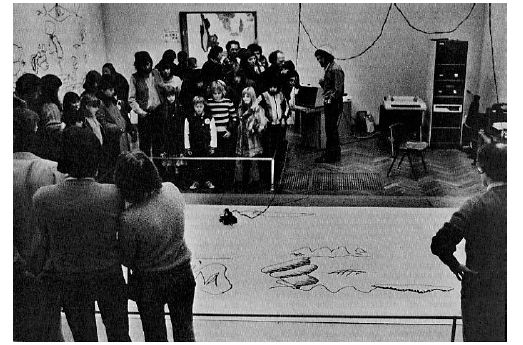
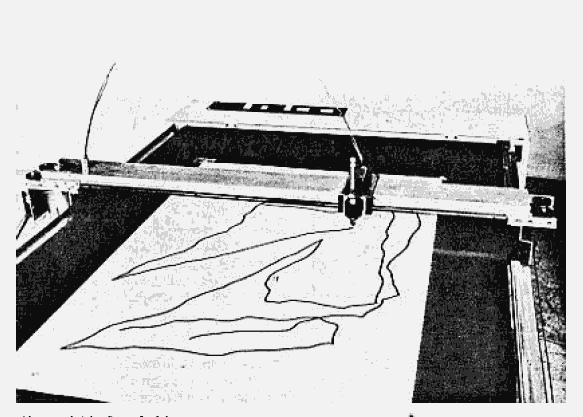
The relationship between machine and art is collaborative, yet complicated. “AI provides the inputs, guide the process, and filter the outputs.” Artist, in this case, is the researcher who studies and breaks down the steps of positioning, drawing, and sizing. For Aaron, Cohen is the person who designs the operational rules for the machine to function. Unlike most artists, Cohen coded the program and built the machine himself. Aaron was designed to produce artwork that was limited to Cohen’s style, which is abstract expressionism. Although Aaron was programmed to paint specific objects, the machine started to generate shapes outside of Cohen’s control. Cohen was impressed with Aaron’s unforeseen artistic decision and their ability to create. He began to commend it for further drawing the subjects besides just reproducing the same copies. It is also important to note that the audience’s interest in Cohen’s machine drawing focuses more on the machine itself rather than the drawing. It poses the question that whether, in this case, Cohen is the artist or the computer engineer?
As AI evolves, this question no longer needs to be concerned. 27 years after Aaron is invented, artists Casey Reas and Ben Fry created “Processing“, a free graphical library and integrated programming environment for electronic arts, new media, and visual design art. This tool is created from artists’ perspectives with a more accessible tool for programming. The interdisciplinary nature of artificial intelligence and its relationship to creativity burry the line between science and art.
The element of math and rationality involves in digital art invokes the form of constructivism in artistic production. The form of AI-generated artwork is not constrained to two-dimensional art. The constructivism of things relies heavily on the theories and implications of its value.
The engineer choice of AI is about “capturing and studying the theory of intelligence, of thinking, and rationality and ultimately of human nature”.
Considering the three foundational approaches in building AI: symbolic-computational, connectional, and neurokinetic. Artificial Intelligence is not only constrained in the engineering solution for the problems but also closely related to the realm of social choice and the risks related to it. “AI involves the translation of philosophies of mind.” During the translation process, there are always some barriers that existed. For instance, AI has perpetuated biases, but it also has the potential to expose those biases. The collective unease that technology brings to the art world, and society at large is unchangeable.
The collective unease and criticism toward AI-generated artwork is the lack of collective rules and knowledge about the technology. What differs from Cohen and most artists who also use programming is the ability to code themselves. Many artists use programming without knowing too much about how to code and how the code functions. As AI becomes more popular and attractive, it is right to question the consciousness of AI-generated artwork given the knowledge gap in computer programming. In 1980, John Searle’s famous critique of AI and his Chinese room argument. The conversational exchange between people who know Chinese can be natural, but very impossible for people who don’t speak Chinese. To proceed with the right response, one must have the consciousness to think.
Searle argues that “an inorganic entity cannot develop intentional states and cannot become conscious”, because the machine will never think, but only act upon instructions given.
Aesthetics of AI error and reproduction
The reproducible feature of AI-generated artwork challenges the history of aesthetics and uniqueness of the artwork. The fact that AI can mass-produce print images or music rhythms removes the personal touch of artistic creation and stimulate the criticism of this new art medium. Just like the intervention of photography replace realism in oil painting in the 19th century. The reproduction of the image replaces the cult value of the artistic production. As Walter Benjamin brings up in his iconic piece, The Work of Art in the Age of Mechanical Reproduction, mechanical reproduction reimagines artworks from the production ritual. As the technology develops to the current state, it is no longer about reproducing the work of art, but more inclined to deigning artwork for reproducibility. The fluidity of authenticity proposes more potential for artistic creation.
The element of mechanical variance brings uniqueness to the work of art it creates. Although AI is an automotive system that can generate artworks according to its programming code, the limitation of machines creates outcomes that are, sometimes unpredicted. The aesthetic value of contemporary artworks is about their conceptuality and intentionality. When AI involves in the creative process, the unprecedented result of the artwork ultimately poses the mistranslation between its presentation and concept. Glitch art is a great example of manipulating analog errors to create an alteration of the image. The authoritative position of the artist is giving up a portion of its space to the uncontrol of the machines. Yet, just like any other art medium, many artists enjoy the “degrees of freedom” when collaborating with AI.
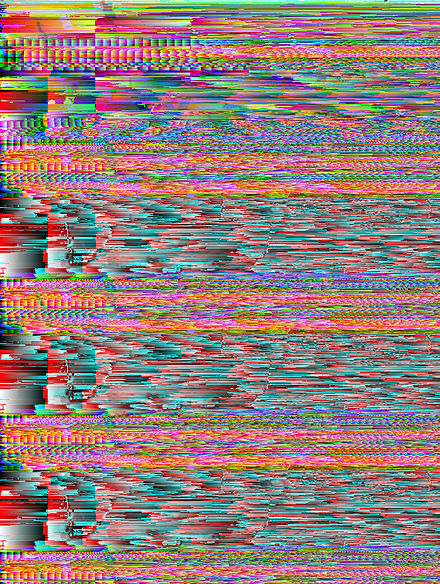
For this newly raised art form, artists are making their own rules. The definition and interpretation of art and technology can be varied in the field. The interpretation of art that is related to technology is deliberate. Art and technology can be seen as the umbrella term for any artwork that is related to technology to a certain extent. The terms, “computer art”, “digital art” and “kinetic art” have very different concepts and aesthetics as artwork engages with the machine in different ways. One may see that interactivity is more important than the physical representation of the art. The other may focus more on the machine itself rather than the audience engagement. The ownership of digital artwork is also up to the artistic intention. The paradigm of artistic ownership along with the constructed machine primarily serves the artistic concept that raises meaningful questions and reflects upon social issues.
The flexible system of creation can refer to Manual Delanda’s idea of limits within the mechanical system. One example is Nam June Paik’s video sculpture, Magnet TV where he altered the television image by placing a magnet on top of the TV. It distorts the broadcast image to an abstract form and the shape changes as the magnet moves. Instead of focusing on the visual appeal of the broadcast image and its transformation, Paik challenged the notion of art as a self-identity by giving the right of alteration to its audience. The interactive nature of the artwork and its happening is the aesthetics of Magnet TV. Whether it’s performance, sculpture, or music, the creative system of developing the conceptual ideas and producing the artwork is about the control of the limit and boundaries of internal error. It is the artistic ownership that gives value to the technology to generate creative results.
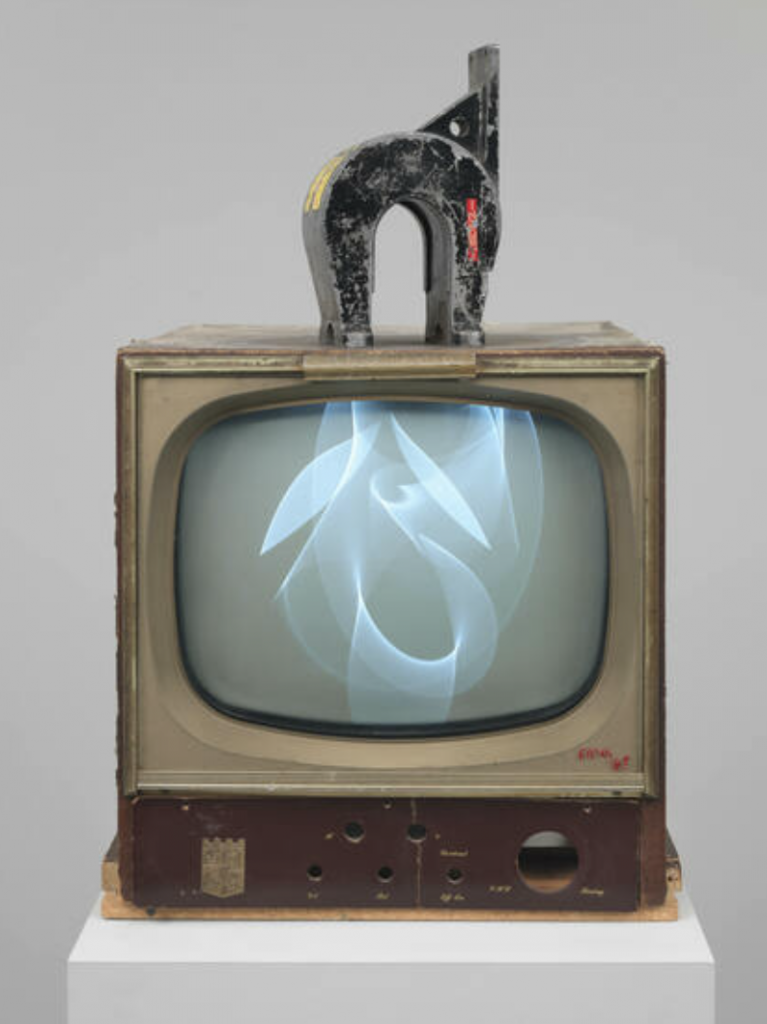
Nowadays, as technology, especially AI becomes more prevalent, AI involves more in-depth in the artistic creation processes. For example, WOMBO Dream is an app that generates text into a drawing. The easy and instant process of creation allows more people to be able to create their artworks with easily accessible apps. It simplifies the artistic creation process by turning it into an easy text to image translation. The path for artistic production is designed and instructed, the artist/user only needs to follow the guideline. Artistic production is replied fully on the machine to construct a concept and visual present by simply giving a prompt. In this case, the machine is taking much ownership of the art. The instant production of artworks increases the number of art existing in the marketplace, which results in changing the competitive landscape for the art business.
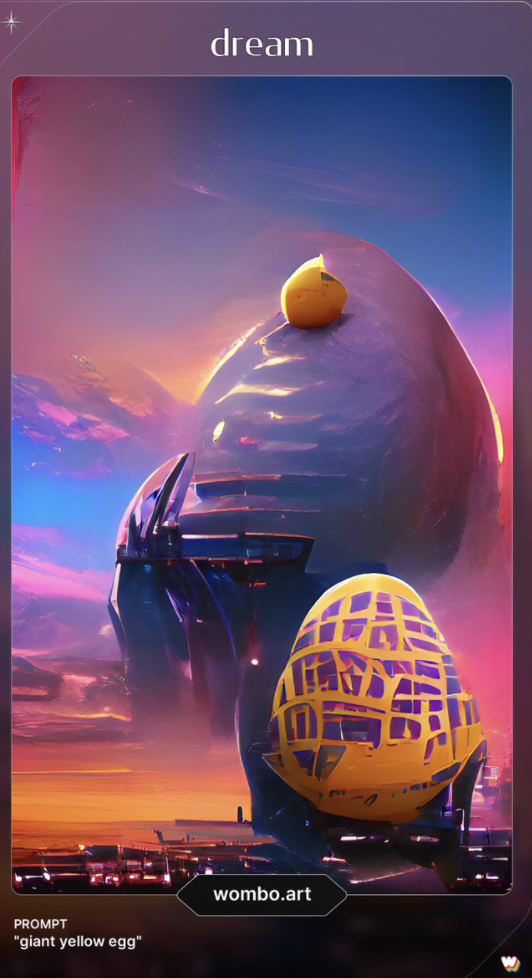
The Frictional Economies of AI-Generated Art
The increasing number of AI-powered art creation machines adds another opportunity for the art collection business. The traditional business model of selling painting, sculpture, and photography is overhauled by raising AI and NFT art. The selling of artwork is about the exchange between money and its ownership. For traditional artworks, ownership is mostly the artist, yet for AI art, ownership is very ambiguous. It is difficult to determine whether this artwork is made and owned by the artist or the machine. It all goes down to the copyright of AI art.
Recently, the U.S. Copyright office refused to grant copyright for an artwork created by an AI machine, Creativity Machine. One of the main reasons for rejection is the lack of human spirit in the work. It raised the concern with all the AI-generated/collaborated artwork. Without the protection of copyright, it is hard to determine who gets to benefit from the art business transaction. There is friction between who makes the work, who owns it, and who gets compensated for selling the work. The denial of the copyright act for AI-generated art poses a stop to the development of AI art in the business world. If there is no fixed right and royalty, it is hard to proceed with the transaction. The question about ownership of art is rising to another level with the mass production of art and involvement of art cryptocurrency.
As the AI-related artwork involved and the understanding of computer art continues to develop, the legal space and arts enterprises will have a more complete system to incorporate with this intervention.
Reference
Akdag Salah, Alkim Almila. “AI Bugs and Failures: How and Why to Render AI-Algorithms More Human?” In AI for Everyone? Critical Perspectives, edited by Pieter Verdegem, 161–79. University of Westminster Press, 2021. https://doi.org/10.16997/book55.j.
Andrews, Jim. “A Philosophy of Computer Art,” n.d.
Barker, Tim. Aesthetics of the Error. Media Art, the Machine, the Unforeseen, and the Errant. Continuum, 2011. https://doi.org/10.5040/9781628927924.
Benjamin, Walter. “The Work of Art in the Age of Mechanical Reproduction,” n.d., 26.
Cohen, Harold. “Meta-Art, Artificial Intelligence and the Work of Harold Cohen,” n.d.
Hetrick, Christian. “Art Created by Artificial Intelligence Can’t Be Copyrighted, US Agency Rules,” n.d., 9.
Lea, Gary R. “Constructivism and Its Risks in Artificial Intelligence,” 2022, 26.
Lovelace, Ada. “Ada Lovelace Wrote Extensive Notes on the World’s First Computer. Her Innovations Foreshadowed Those Used in Twentieth-Century PCs.,” n.d., 6.
Mateas, Michael. “Expressive AI: A Hybrid Art and Science Practice.” Leonardo 34, no. 2 (April 2001): 147–53. https://doi.org/10.1162/002409401750184717.
Menkman, Rosa (2011), “Glitch Studies Manifesto” (PDF), in Lovink, Geert; Somers-Miles, Rachel (eds.), Video Vortex Reader II: Moving Images Beyond YouTube, Amsterdam: Institute of Network Cultures, pp. 336–347, ISBN 978-90-78146-12-4, archived from the original (PDF) on 2011-08-27
Manuel DeLanda, Intensive Science and Virtual Philosophy (London: Continuum, 2002), 13.
Rea, Naomi. “How Did A.I. Art Evolve? Here’s a 5,000-Year Timeline of Artists Employing Artificial Intelligence, From the Ancient Inca to Modern-Day GANs.” n.d., 10.
Somaya, Deepak, and Lav R Varshney. “Ownership Dilemmas in an Age of Creative Machine,” Issues in Science and Technology, 2022, 8.